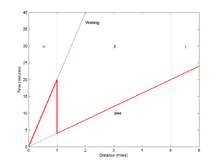Region-beta paradox

The region-beta paradox denotes the phenomenon that people can sometimes recover more quickly from more intense emotions or pain than from less distressing experiences. The hypothesized reason is that intense states trigger psychological defense processes that reduce the distress, while less intense states do not trigger the same psychological defense processes and, therefore, less effective attenuation of the stress occurs. However, people typically predict intense states to last longer.[1]
The paradox has been observed in the psychological effects of exposure to terrorist attacks.[2] This is likely related to activation of coping, cognitive dissonance and other forms of mental mobilization.[3][4][5]
It has been computationally modelled in an affective computing model.[6]
Origin of name
The name originates from the illustration in the paper by Gilbert et al.[1] that introduced the paradox. They consider a commuter who has the habit of walking to destinations within a mile of her origin, and biking to more distant destinations. Since the bike is faster the commuter will reach some distant locations more quickly than a nearer destinations (region beta in their diagram), reversing the normal tendency to arrive later at more distant locations.
This non-monotonicity applies to states where interventions can be chosen, but are not chosen below certain thresholds (because of cost etc.). For example, injured people may be more likely to seek out effective means to speed their recovery (taking medicine, going to a doctor, undergoing surgery) when the injury is more severe than for mild injuries, making the lesser injuries last longer.
A trick knee hurts longer than a shattered patella because the latter injury exceeds the critical threshold for pain and thereby triggers the very processes that attenuate it.— Gilbert et al. 2004
See also
References
- 1 2 Gilbert, Daniel T.; Lieberman, Matthew D.; Morewedge, Carey K.; Wilson, Timothy D. (2004). "The Peculiar Longevity of Things Not So Bad" (PDF). Psychological Science. 15 (1): 14–19. doi:10.1111/j.0963-7214.2004.01501003.x.
- ↑ Brandon, Susan E.; Silke, Andrew P. (2007). "Near- and Long-Term Psychological Effects of Exposure to Terrorist Attacks". In Bongar, Bruce; Brown, Lisa M.; Beutler, Larry E.; Breckenridge, James N.; Zimbardo, Philip G. Psychology of Terrorism. Oxford: Oxford University Press. doi:10.1093/med:psych/9780195172492.003.0013. ISBN 9780195172492.
- ↑ Zimbardo, P. G.; Cohen, A. R.; Weisenberg, M.; Dworkin, L.; Firestone, I. (1966). "Control of Pain Motivation by Cognitive Dissonance". Science. 151 (3707): 217–219. doi:10.1126/science.151.3707.217. PMID 5907915.
- ↑ Taylor, Shelley E. (1991). "Asymmetrical effects of positive and negative events: The mobilization-minimization hypothesis." (PDF). Psychological Bulletin. 110 (1): 67–85. doi:10.1037/0033-2909.110.1.67. PMID 1891519.
- ↑ Wilson, Timothy D.; Gilbert, Daniel T.; Centerbar, David B. (2003). "Making Sense: The Causes of Emotional Evanescence" (PDF). In Brocas, Isabelle; Carrillo, Juan D. The Psychology of Economic Decisions. Oxford University Press. ISBN 9780199251087.
- ↑ Steephen, John E. (2013). "HED: A Computational Model of Affective Adaptation and Emotion Dynamics". IEEE Transactions on Affective Computing. 4 (2): 197–210. doi:10.1109/T-AFFC.2013.2.